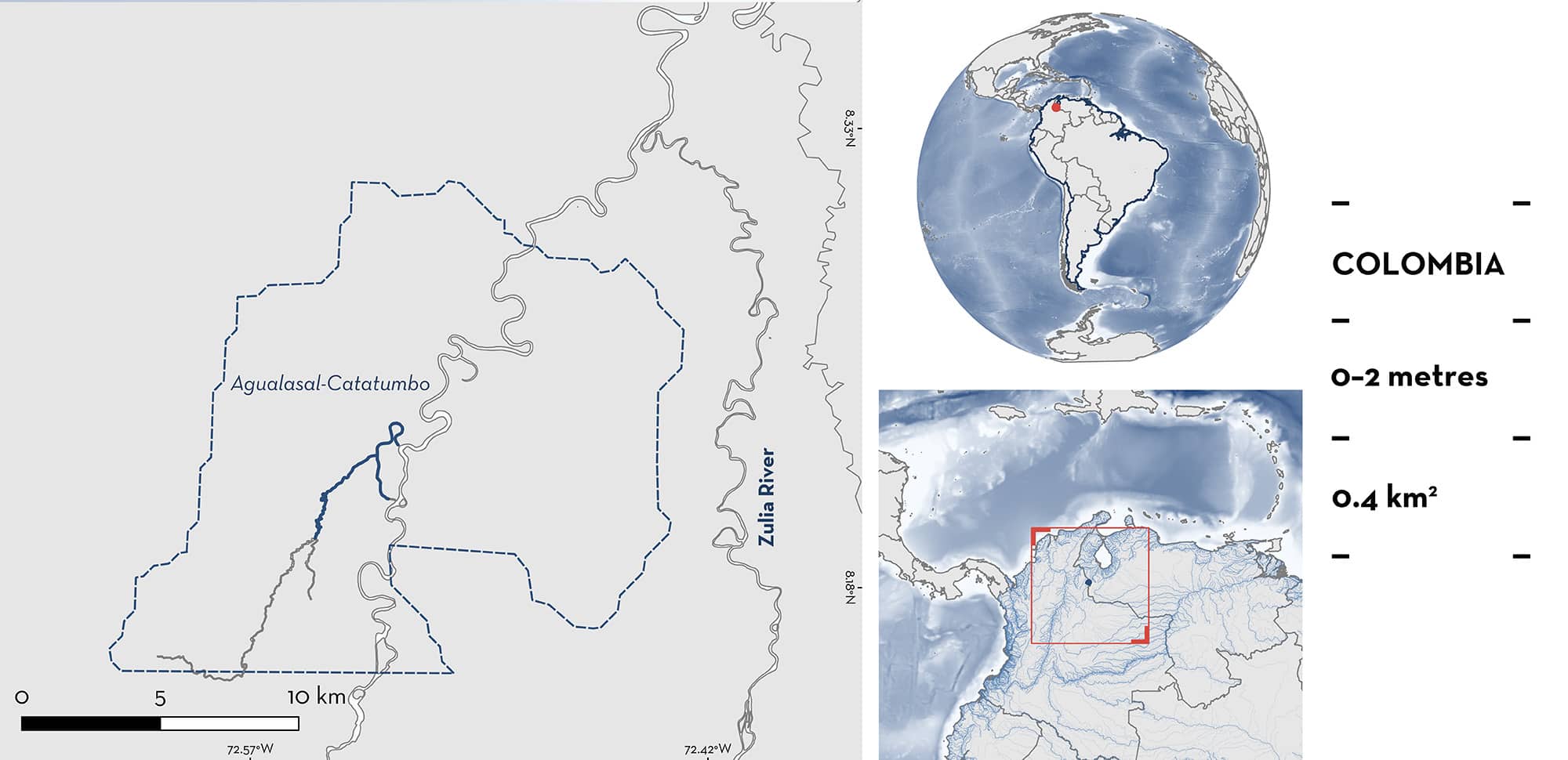ISRA FACTSHEETS
ISRA FACTSHEETS
SOUTH AMERICAN INLAND WATERS
Agualasal-Catatumbo
Summary
Agualasal-Catatumbo is located in Colombia. It is situated in the middle section of the Catatumbo River sub-basin in Norte de Santander Department. This area is a tributary of the Catatumbo River, and is characterised by dark brown waters, heavily sedimented, and a riverbed composed of stones covered in mud. Within this area there are: threatened species and range-restricted species (Maracaibo Freshwater Stingray Potamotrygon yepezi).
Download factsheet
Agualasal-Catatumbo
DESCRIPTION OF HABITAT
Agualasal-Catatumbo is located in Colombia. It is situated in the middle section of the Catatumbo River sub-basin in Norte de Santander Department, near Zulia River. This area is a creek that becomes a tributary of the Catatumbo River.
The Catatumbo River sub-basin originates in Cerro Jurisdicciones in Colombia. The river is 520 km long up to its mouth in the Venezuelan Lake Maracaibo. This sub-basin is topographically complex, with high mountains, highland plains, canyons, foothills, and lowland alluvial zones (Graca et al. 2025). This area has characteristics unlike areas found in other regions of the Catatumbo River sub-basin. It is characterised by dark brown waters, heavily sedimented, and the riverbed is composed of stones covered in mud (A Ortega-Lara pers. obs. 2011). Precipitation is bimodal with maximum rainfall between April–May and September–November, and at its lowest between January–March, and June–August (Graca et al. 2025).
This Important Shark and Ray Area is benthic and is delineated from surface waters (0 m) to 2 m based on the bathymetry of the area.
CRITERION A
VULNERABILITY
One Qualifying Species considered threatened with extinction according to the IUCN Red List of Threatened Species regularly occurs in the area. This is the Endangered Maracaibo Freshwater Stingray (Lasso-Alcalá et al. submitted).
CRITERION B
RANGE RESTRICTED
This area holds the regular presence of Maracaibo Freshwater Stingray as a resident range-restricted species (A Ortega-Lara pers. obs. 2011; Ortega-Lara et al. 2012).
In 2011, scientific surveys were conducted, using electric fishing, at several sites within the range distribution of this species: middle section of the Zulia River (El Zulia and Puerto Santander communities), the Catatumbo River (La Gabarra community), and the Agualazal Creek (Agualazal village) within this area (Ortega-Lara et al. 2012). The species was only found in this area with five individuals sampled (A Ortega-Lara pers. obs. 2011; Ortega-Lara et al. 2012). According to five fishers from El Zulia and Puerto Santander communities from adjacent zones inside the species distributional region, Maracaibo Freshwater Stingray is very common in this area and this location might function as reproductive site for neonates (A Ortega-Lara pers. obs. 2011). A pregnant female was also documented in this area, indicated by the presence of embryos (Lasso et al. 2013). This is the only known area with regular and predictable observations of Maracaibo Freshwater Stingray, and the area with the most contemporary records for this species.
The Maracaibo Freshwater Stingray is endemic to the Maracaibo Lake Basin, in northwest Venezuela (Zulia, Mérida, and Trujillo states) and northeast Colombia (Norte de Santander Department). In Colombia, this species has been recorded for the middle and lower parts of the Catatumbo River sub-basin (Lasso-Alcalá et al. submitted).
The historical records (Fernández-Yépez & Espinoza 1970; González-Bencomo & Borjas 2003; Casler et al. 2012; Lasso et al. 2013) throughout the Maracaibo River Basin indicate that this species is not commonly found and has an occasional distribution with a low population abundance (Lasso-Alcalá et al. submitted).
Download factsheet
SUBMIT A REQUEST
ISRA SPATIAL LAYER REQUEST
To make a request to download the ISRA Layer in either a GIS compatible Shapefile (.shp) or Google Earth compatible Keyhole Markup Language Zipped file (.kmz) please complete the following form. We will review your request and send the download details to you. We will endeavor to send you the requested files as soon as we can. However, please note that this is not an automated process, and before requests are responded to, they undergo internal review and authorization. As such, requests normally take 5–10 working days to process.
Should you have questions about the data or process, please do not hesitate to contact us.


